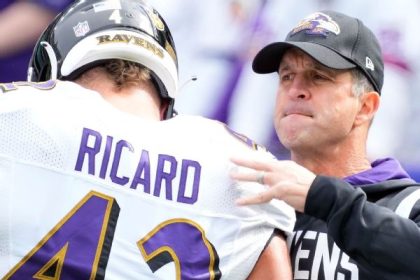You won’t find many NFL Draft groups better than this year’s crop of tight ends. Roughly a dozen players have a chance to go in the Top 100, and it’s hard to find a position (outside of QB) with more buzz right now.
One year after we saw an absurd 19 tight ends get drafted, this 2023 group could top that.
It’s led at the top by universally acclaimed names like Notre Dame’s Michael Mayer and Utah’s Dalton Kincaid. But there’s intrigue all the way through the group — from high-profile prospects like Georgia’s Darnell Washington to lesser-known names like South Dakota State’s Tucker Kraft or Old Dominion’s Zack Kuntz.
[Related: NFL Draft TE rankings: Dalton Kincaid leads ‘unique’ top 10]
With such a wide array of prospects, it’s a safe bet the position is going to be drafted often — and potentially early — when the draft finally begins next month. And that’s the crux of this conversation. Because as exciting as some of these prospects are, I can’t help but think the league’s track record at the position is spotty.
To make sure I wasn’t imagining things, I charted every tight end selection dating back to 2011. It felt like a good jumping-off point for multiple reasons. That’s the year the NFL’s Collective Bargaining Agreement created the slotted rookie pay scale we know now, and it also reflects the way spread offenses created a tight end position that’s often unrecognizable from the way it was played in the 90s and 00s.
The results indicate one thing clearly: be wary of spending big resources on a position that requires so much development.
ADVERTISEMENT
It isn’t a hard conclusion to arrive at. Only nine tight ends have been drafted in the first round since 2011, with the league opting not to select one in the first round in six of the last 12 drafts.
It’s a small sample size, but not a good one. We’ll hold off on making judgments about Kyle Pitts, as he’s only halfway through his rookie contract. Of the other eight, only one — David Njoku — signed a long-term extension with the team that drafted him.
That’s not to say you can’t find a great tight early in the draft. Eric Ebron, Evan Engram and T.J. Hockenson have all made Pro Bowls after being taken in the first round. Pro Bowls alone never tell the full story, though. Ebron made the Pro Bowl with Indianapolis, a year after leaving his original team. Engram’s lone Pro Bowl appearance with the New York Giants wasn’t enough to prompt them to keep him around. Hockenson is a two-time Pro Bowler, though he earned the second one in Minnesota — where he was traded midway through last season.
Tyreek Hill credits Chiefs TE Travis Kelce for his development at WR
Shannon Sharpe asked Tyreek Hill to reveal his mentors when he entered the NFL as a member of the Kansas City Chiefs. Tyreek said: “(Travis) Kelce really put his arms around me and really taught me the way. We don’t play the same position but he broke down certain ways to play the game.”
Pro Bowls can’t be the only measurement of success, of course. After all, there are only four tight end spots on a given Pro Bowl roster. Even still, the results don’t look much better when you lower the bar.
I decided to adjust my expectations to see how many first-round tight ends were their team’s primary starters for at least two or three seasons. That number felt important, as it would suggest a player was at least capable of starting over half of his rookie contract.
Five of nine players meet the criteria, which is better. It’s still not great when you remember that two of them, Hockenson and Noah Fant, were traded away by the teams that selected them. Again, it feels early to judge Pitts’ tenure in Atlanta, but it’s impressive to note that he has started 25 of 27 possible games to this point in his career.
There is a sweet spot to be found here somewhere. Day 2 of the draft, somewhere between picks 33-90, has produced some of the league’s best tight ends, between Travis Kelce, Zach Ertz, Dallas Goedert and Mark Andrews.
In fact, across the time span we’re looking at, there have been 57 tight ends selected between Rounds 2-4 of the draft, and 27 have gone on to become regular starters. That’s almost a 50% hit rate, which feels strong in the uncertain world of the NFL draft. It’s much more encouraging than the first-round results, and it’s a significant step up from the later rounds, where you’re truly throwing darts.
It emphasizes the eternal debate in the draft world about talent and positional value. Is it smart to invest big-time capital on a position that often requires time to develop, even for its most productive players? Is there a line of demarcation where the risk becomes worth the reward — whether that be the back end of the first round, the middle of Day 2 or even potentially later on?
As we see every year, those questions can be answered 32 ways by 32 teams. Public opinion doesn’t do much to sway the methods different teams use to grade their players or set their boards.
But as this draft draws closer, it feels worthwhile to remember what gets asked of this position at the highest level, and what history tells us about that track record.
I don’t write any of this to suggest that a first-round tight end can’t be successful. Pitts was my favorite prospect in the 2021 class, and I’m still bullish on his future. Still, when we’re talking about the most valuable draft capital, I’m going to take it into account.
David Helman covers the Dallas Cowboys for FOX Sports. He previously spent nine seasons covering the Cowboys for the team’s official website. In 2018, he won a regional Emmy for his role in producing “Dak Prescott: A Family Reunion” about the quarterback’s time at Mississippi State. Follow him on Twitter at @davidhelman_.
Top stories from FOX Sports:
NFL trending

Get more from National Football League Follow your favorites to get information about games, news and more













